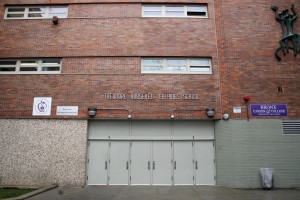The 15 students in Natalie Harrington’s senior English class at New Day Academy in the Bronx were hard at work on a recent afternoon, writing about a scene from Emily Bronte’s novel Wuthering Heights. Their heads were bent over their papers as they puzzled over what would happen next between sickly Linton and the bitter Heathcliff. The room was silent.
Then, one of Harrington’s most challenging students returned from the bathroom. He meandered over to his desk and sat down grinning, fidgeting, singing quietly. He announced to anyone who would listen that he was tired. A few students looked up and stared at him. He groaned loudly and told the whole class that his back hurt. Harrington walked over to his desk and pointed to his paper. She told him to start working. “I’m sick,” he responded. “Like Linton!”
Harrington couldn’t help but smile. Two years ago, Harrington said she couldn’t even get him to sit in his seat.
That was back when things were different at New Day Academy, a small, public school that opened with great promise seven years ago.

The school was the brainchild of Principal Paul Schwarz, an educator in the celebrated Central Park East network of progressive schools of choice in East Harlem. Like the CPE schools, New Day Academy employed project-based learning and oral and written presentations in lieu of formal graduation exams. Students still only take the English Regents, and have waivers from the others.
In New Day’s earliest years, some students had access to a selective program at Bard High School Early College in Manhattan. Many young teachers were recruited to carry out the progressive curriculum. In the first year of operation, 80 percent of the teachers had fewer than three years of experience.
Somewhere along the way, things went wrong. Schwartz, the founding principal, retired only a year after the school opened. The percentage of students eligible for free lunch rose by 16 points in three years. Suspension rates went up too. In the 2008-2009 school year, there were 95 suspensions for 481 students, nearly five times the amount in 2006. In 2010, only 13 percent of students were on grade level.
Then a new principal, Mara Ganeles, took over in 2009. Harrington said Ganeles made it clear that poor behavior would not be tolerated. Students started getting consequences for their actions.
Last year, the school had one of the highest suspension rates in the city–311 for only 339 kids. Not everyone agrees, but Harrington, now in her third year of teaching, believes that suspensions were necessary to regain control in a place where kids thought they could do whatever they wanted.
Harrington started at New Day in 2009 as a Teach For America corps member, after completing a five-week training session that included teaching summer school in a New York City school. She said her first year was rough. Grissely Ramirez, a senior in Harrington’s English class, said that things were chaotic then. “You’d be in the classroom and there’d be crazy people outside running around,” she said.
In 2009, the Department of Education flagged New Day as a school to be added to the shut down list. It cited persistently low performance and a lack of ability to turn the school around. The United Federation of Teachers sued to keep several schools open, including New Day, but lost its battle. The Department of Education officially “closed” the school in 2011, meaning it stopped admitting new students and started a phase out process.
Some students believe the odds were stacked against them from the beginning. Seventeen-year-old Grissely said she thinks that closing the school down was the Department of Education’s plan all along. She believed the students weren’t given the chance to show progress, which she says is unfair. “It’s not necessarily everybody in the school who did bad. There’s a lot of people who do good things and do get good grades,” she said. Her classmate, Melissa Garido, agrees. “I feel like they just didn’t have hope in us anymore, and that’s not okay.”
Deborah Meier, founder of the nationally renowned Central Park East Secondary School that New Day is mirrored after, said that New Day was up against tough circumstances from the beginning. She said that while the staff was excited about the progressive curriculum, they were lacking skills that come with experience. She also stressed the benefit of having secondary students who attended a like-minded, high quality elementary school.
The majority of students that attended Meier’s school came from one of the Central Park East elementary schools. “They had a different kind of elementary education, so that affected them and their classmates,” Meier said, adding that her school had a higher percentage of kids with strong intellectual habits and aspiration that were in place when they started middle school. She added that when new kids came to the school, they were influenced by their high performing peers, whereas New Day Academy received students who may not have been adequately prepared. “It was a harder population to work with.”
Meier’s schools have since seen some hard times, but were initially very successful. During the earliest years of operation, the Central Park East schools experienced tremendous success. No students were suspended during the first decade of operation, and in 1991 and 1992, over 90 percent of the graduating classes went to college. Meier said that New Day’s founding principal, Paul Schwarz, was attempting to start a progressive portfolio-based school at a time when there was a focus on testing, unlike the climate when she started her school in 1985. “In a sense, he didn’t have the advantage of being part of the climate and culture,” Meier said, adding, “It’s hard to go against the grain.”
Meier said that if Schwarz hadn’t retired for health reasons, he may have had a shot at building a successful school. She met with New Day staff members several times, but says it was hard to bolster morale and build skills necessary to successfully pull off a progressive curriculum that wasn’t focused on testing, unlike the majority of schools.
The staff of New Day Academy hasn’t given up yet. Harrington, Grissely, and Melissa say the school has ironically gotten better since the closure was announced. But it’s hard to tell with evidence. New Day no longer gets a grade on the annual progress reports from the New York City Department of Education. Special Education Teacher Lauren Weick says that it seems the district doesn’t care what New Day does until 2014, when they will graduate their last class. “We’re not even being held accountable for what happens in the next two years with these students,” she said.
Weick, a first-year teacher, said she knew she was joining a sinking ship but never realized how much the closing would impact her classroom. The students are very aware of the facts behind the closure. “I think subconsciously it really affects how they perform in school, “ she said. “I don’t think they realize that they’re probably performing lower because they know that the higher ups have given up on them. That’s how it seems to them.”
As the school has started to phase out, it has lost some of its progressive ideas. Weick has trouble remembering the five “Habits of Mind:” qualities like “perspective,” and “supposition” that used to be frequently included into lessons. These were part of New Day’s progressive ideology, which has since disappeared.

The outside of New Day’s building shows no evidence that the school, which now has only about 186 students left, is still open. New Day is located inside a building with three other schools. The other schools have banners on the front of the building, but New Day does not. The only sport available for students is boy’s basketball. And currently, 13 percent of students are overage for their grade.
Ninth grade is no longer offered at the school, so students must complete credit recovery courses while enrolled in in a higher grade. Harrington’s senior English class has several students who haven’t passed 10th or 11th grade English. Some students who are even further behind have the option of attending evening class at a Young Adult Borough Center, or YABC, to earn credits back. Harrington worries about students who may transfer to a high school where they will have to take the Regents exam.
“That terrifies me,” she said. “The focus here has never been on prepping them for the Regents.” She said that taking a Regents exam is a skill in itself, and while teachers at other schools do activities to prepare students for the exam, New Day focuses on portfolios and projects.
Harrington said the school is going backwards, not in a bad way, but to a more structured environment. She said things have calmed down this year and students have gotten out of the mindset that they are terrible students because the school is closing. She barely thinks about the phase out, and is focusing on making sure her students are ready for college. She wants her students to be comfortable going into a classes next year and discussing literature. She said she is focused on exposing her students to material that other kids in more affluent schools are reading, so when they get to college they won’t feel like they missed out on a quality education.
Many of Harrington’s students will graduate this year. Those who are further behind have been given options to transfer to other schools. The Department of Education stated in its phase out plan for New Day that current students who are on track to graduate will be given the opportunity to complete their education at the school.
Grissely and Melissa are graduating in June and plan on attending college, but are still concerned about their school. “I don’t think it affects us as much,” Melissa said. “But I think other kids that have to make up school credits. It will affect them a whole bunch because now they have to start over somewhere new.”
As the school graduates each class and shrinks in size, teachers are put in a “reserve pool” or forced to find new jobs. Melissa says it’s been hard to watch the exodus of teachers after the school started closing. “It’s sad to see a bunch of good teachers- the school has a bunch of wonderful teachers- leave and have to go elsewhere,” she said. But she acknowledges that the improvement is noticeable.
“I feel like everybody’s matured,” she said. “We’re to a point where we know what we have to do and some of us do it.”
View 2012 Closing Schools in a larger map


